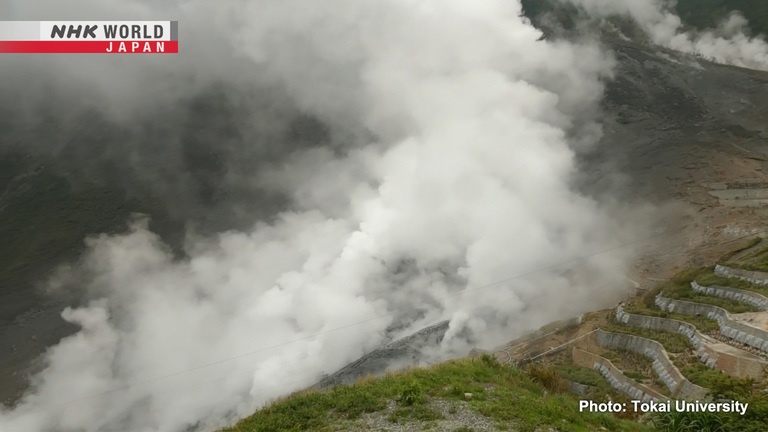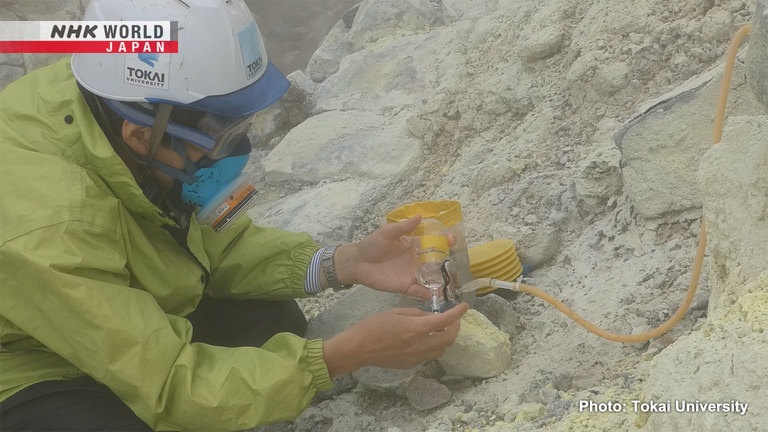#19 Phreatic Eruptions
Mt. Ontake is located on the border of Nagano and Gifu prefectures. Standing 3,067 meters above sea level, it is a popular daytrip hiking spot for mountain enthusiasts. Mt. Ontake was crowded with climbers around noon during a September vacation season, when the sudden stream-driven "phreatic eruption" occurred. Many climbers panicked as they encountered this unexpected natural phenomenon. Why couldn't this eruption be predicted? According to experts, there are 3 main types of volcanic eruptions, and the warning signs of phreatic eruptions are the hardest to detect. Now researchers are making advances to detect the slightest signs of an eruption using observation satellites and chemical approaches. Find out the latest on the research of volcanic predictions.



Transcript
Japan has a long history of natural disaster.
Now, the power of science is helping to overcome them.
BOSAI - Science that Can Save Your Life.
On Saturday, September 27, 2014, Mt. Ontake, crowded with climbers, suddenly erupted.
58 people were killed, and 5 are still missing.
This is an unprecedented volcanic disaster that claimed the lives of many climbers.
Situated along the border of Nagano and Gifu, Mt. Ontake stands 3,067 meters above sea level.
It is a popular daytrip hiking spot for mountain enthusiasts.
The eruption occurred near the summit.
This was around noon when it was crowded with climbers.
What exactly happened at that time?
OGAWA Sayuri is a mountain climbing guide.
She was climbing alone near the summit when the eruption occurred.
Were there any warning signs?
Not at all. I was just climbing down
when I heard a rumble.
I turned around to see what it was... and BOOM!
The crater is located near the summit.
There were close to 200 people around the summit.
Black grains covered the sky,
and then I noticed flying rocks.
I heard one loud scream.
A person was hit by a rock.
Investigations revealed that rocks of more than 10 centimeters in diameter rained down on the area around the summit at speeds of up to 300 kilometers per hour.
Some were as big as 80 centimeters across, which were powerful enough to break through the walls of the mountain lodge.
Nature is truly terrifying and
cannot be controlled by human efforts.
At the time, no volcanic warnings were issued.
So why couldn't they predict the eruption?
Today, we'll look at the mechanisms of volcanic eruptions and find out about the latest advances in volcanic predictions.
Japan is one of the top countries with the most volcanoes.
There are 111 active volcanoes with a history of repeated eruptions.
This accounts for about 7% of the world's active volcanos.
The reason behind such a large number, stems from the fact that the Japanese archipelago is located on the boundaries of several tectonic plates.
Volcanoes in Japan were created by plates, sinking under the Japanese Islands.
In areas around 100 km below the surface of the plate, rocks begin to melt due to high pressure and temperature.
This is how magma is formed.
They make their way upward over a long period of time, while creating pools of magma along the way.
This is how volcanoes are formed.
So why was the eruption of Mt. Ontake so unpredictable?
Eisuke FUJITA, an expert in volcanic disaster prevention, explains there are different types of eruptions.
There are 3 main types.
Magmatic eruption has clear signs, because
magma rises directly from underground.
Phreatic eruption, such as Mt. Ontake,
is the hardest to predict.
There are two types of eruptions with easily recognizable warning signs: One is magmatic eruption in which magma shoots up directly toward the surface.
The other is phreatomagmatic eruptions, in which magma comes into direct contact with fluid such as groundwater, generating steam explosions.
Both eruptions are caused by magma rising.
For eruptions caused by rising magma...
First, there is movement underground.
Magma rises and breaks through
the bedrock, causing earthquakes.
Frequent earthquakes are one of the signs.
Furthermore, as magma nears the surface, the mountain expands, causing the ground to swell and the inclination of the mountain to change.
It is said that such precursors are often observed several days before an eruption, giving time to issue warnings and to evacuate.
However, the Ontake eruption was a phreatic eruption which does not directly involve magma.
Phreatic eruptions are steam-driven explosions that occur when groundwater pressure builds up, due to rocks and gases being heated up by magma.
Compared to eruptions caused by rising magma, phreatic eruptions are smaller in scale and their precursory signals are harder to detect.
A mountain could erupt without magma.
In such cases, you may get fewer
earthquakes before the explosion.
Mountains probably expand a little,
but they're hard to detect.
Phreatic eruption precursors occur in a small area and are weak.
That's why it had been difficult to forecast.
Mt. Ontake had been experiencing small earthquakes for about 20 days, but the frequency decreased before the eruption.
This was not enough to determine as a sign leading to an eruption.
Also, the swelling of the ground was confirmed, only a few minutes before the eruption.
These are the reasons why eruption warnings, necessary for mitigating disaster, could not be issued.
Now, Fujita believes that there needs to be even more focus on observing volcanic eruptions.
The reason stems from the Great East Japan Earthquake of 2011.
This massive earthquake had caused the continental plate to move, stretching the Japanese archipelago up to 5 meters eastward, particularly in the Tohoku region.
When the ground is stretched, gaps are created in the bedrock and magma can easily rise.
This increases the likelihood of magmatic eruptions.
In addition, water can easily accumulate in the bedrock gaps.
And when rocks heated by magma are nearby...
It could cause groundwater to boil.
Phreatic eruptions are difficult to predict, as they occur with little or no precursors.
Learning from the deadly Mt. Ontake eruption, research is now being conducted from various approaches.
Today, we will look at air and ground observations.
In June 2015, the first eruption in recorded history of Mt. Hakone's Owakudani was confirmed.
It was a phreatic eruption, the same as the Ontake eruption.
In the Owakudani eruption, researchers were able to capture precursor phenomena using two different approaches.
The first was satellite observation.
It captured the very slight expansion of the mountain, which is believed to be the world's first.
The earth observation satellite "Daichi-2" was launched in May 2014.
It orbits roughly 600 km above the Earth to observe changes on the surface of Japan.
"Daichi-2" can detect the unevenness of the earth's surface with an accuracy of a few centimeters by using special electromagnetic waves that can pass through clouds and forests.
The satellite passes over the same location once every two weeks.
If the ground had expanded or changed during that period of time, the slightest difference can be caught by comparing it to the previous data.
The changes in the ground occurred approximately two months prior to the phreatic eruption, in a very small area of about 200 meters in diameter centering around Owakudani.
Compared to the surface before the eruption...
It was confirmed that the surface had risen by as much as 6 cm.
The phreatic eruption occurred right at that spot.
It is possibly the first time in the world that a precursor to a phreatic eruption had been captured.
The second approach was analyzing volcanic gases.
This area of Owakudani is full of vents known as fumaroles.
Volcanic gases are emitted from the fumaroles.
Professor Takeshi OHBA of Tokai University conducts research on the relationship between volcanic gases and phreatic eruptions.
How are volcanic gases related to
phreatic eruptions?
The eruption occurs because the pressure
of the hydrothermal reservoir rises.
When the ground can no longer
withstand it, the mountain erupts.
We need to know more
about the hydrothermal reservoir.
It's formed when volcanic gases
get into the groundwater.
According to Professor Ohba, volcanic gases are the driving force that heats groundwater, turning it into steam.
More that 90% of volcanic gas is steam.
It also contains other gases such as carbon dioxide and helium dissolved in magma, and hydrogen sulfide and methane coming from underground water.
What can volcanic gases tell us?
The ratio of CO2 and hydrogen sulfide.
Also the ratio of helium and methane.
The changes in these ratios are
strongly related to seismic activity.
Prior to the eruption, there was a surge in the number of small earthquakes in and around Owakudani.
Professor Ohba discovered that when the number of earthquakes increased, the amount of carbon dioxide in the volcanic gas increased, compared to hydrogen sulfide.
And when the number of earthquakes decreased, the amount of carbon dioxide also decreased.
This graph shows the number of earthquakes and the amount of carbon dioxide in volcanic gases.
The number of earthquakes peaked in June 2015, when the phreatic eruption occurred, and the amount of carbon dioxide in the volcanic gas also increased, resulting in a graph similar to the earthquake graph.
If these conditions persist for a long time, the underground pressure will continue to build up, increasing the likelihood of phreatic eruptions.
I hope to move forward with research,
teaming up with vocanologists worldwide.
Professor Ohba believes that, in the future, it will become possible to predict phreatic eruptions with greater accuracy, by analyzing the combined data on seismic activities and mountain expansion.
We learned that steady progress is being made in the research to mitigate volcanic disasters.
As individuals, it's important to know the characteristics of the mountain you plan to climb or are near, and be aware of the possibility of phreatic eruptions.